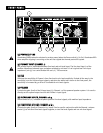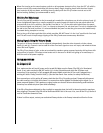
11
TToouucchhuupp
For an overall finish enhancement and protective coating, use gloves to apply a plastic finish protector,
such as Armor-All
®
protectant, to the surface of the plastic cabinet only. Note that the cabinet will be
slippery after these treatments; rub them down vigorously with a dry, lint-free cloth to minimize this.
CChheecckk ffoorr SSeeccuurree HHaarrddwwaarree
After the first few months of use and periodically thereafter, check the hardware of the PR 15P for
tightness, including the rear panel screws and the screws that hold the baffle and rear cabinet together.
The unit is subject to a great deal of vibration, and this could cause them to loosen with use.
AArrcchhiitteeccttuurraall aanndd EEnnggiinneeeerriinngg SSppeecciiffiiccaattiioonnss
The powered loudspeaker system shall have a frequency response from 47 Hz to 20 kHz. The peak SPL
with inaudible distortion shall reach 120 dB with music as a source, when measured at a distance of 1M
and driven to full output capacity. The system shall utilize a 15" heavy duty woofer and an RX
™
14
compression driver tweeter. The nominal radiation pattern shall be 90˚ in the horizontal plane, and 40˚ in
the vertical plane.
The powered, bi-amplified loudspeaker system shall have a group of medium impedance input connectors
consisting of one combo female XLR and 1/4" TRS phone jack, and two 1/4" phone jacks, on the rear
panel. A volume control will be located near each input jack. The combo female XLR and 1/4" TRS phone
jack will have a gain adjust pad that provides for switching between line-level input signals, and mic-level
input signals.
The system power amplifiers shall have an unfiltered frequency response of 10 Hz to 30 kHz which
deviates no more than +0, -1 dB up to rated power, a damping factor greater than 100 @ 1 kHz into
8 Ohms, hum and noise better than 90 dB below rated power, and THD and IMD of less than 0.1%. The
woofer amplifier shall be capable of 150 W into a 8 Ohm nominal load, and the tweeter amplifier shall be
capable of 50 W output into a 8 Ohm load, and both shall incorporate independent DDT
™
compression.
The input signal shall be electronically divided into high frequencies and low frequencies by a staggered-
pole, third order slope line-level crossover at 2 kHz. The low frequencies shall be processed to provide
bass boost, subsonic filtering and overall response shaping, and the high frequencies shall be equalized
for constant directivity horn EQ- and response-shaping.
The enclosure shall be constructed of injection-molded polypropylene of 1/4" nominal thickness with a UL
flame rating, and reinforcing ribs internally. A handgrip shall be molded-in on the top rear edge, and one
on each side of the woofer.
A powder-coated metal grille shall be provided for woofer protection. The cabinet shall incorporate a pole
mount for speaker stand use, four tall sturdy rubber feet for floor standing use, and four mounting point
inserts on the top and bottom each for flying use.
The outside dimensions shall be: 28.56" tall by x 21.31" wide (11.50" in rear) by x 17.00" deep, and the
weight shall be 52 lbs. Power requirements shall be: 100 Watts nominal, 120 VAC, 60 Hz domestic and
240 VAC, 50 Hz (European). The loudspeaker system shall be called a Peavey PR15P.


















